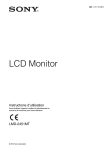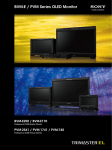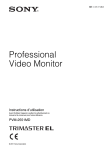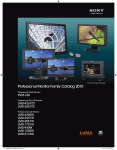Download LMD-2451MT
Transcript
LMD-2451MT Medical 3D LCD Monitor In recent years, digital technologies for stereoscopic three dimensional (3D) image processing and monitoring have progressed rapidly. This is particularly true of 3D imaging for medical use. Some types of 3D monitoring systems are already used in medical modality applications. However, most of these are based on SD (standard-definition) resolution. Today’s users are unhappy with this level of 3D picture quality and the way it compromises the usability of conventional 3D monitoring systems for endoscopic surgery. Newer systems which incorporate improved digital technologies for 3D monitoring, including HD (high-definition) resolution, are of greater value in medical modality applications. Now, Sony introduces a high-performance medical 3D LCD monitor – the LMD-2451MT, 24-inch*1 WUXGA (1920 x 1200 pixels) resolution monitor – to its comprehensive lineup of medical-grade displays. The LMD-2451MT incorporates a circular-micro polarizer filter attached to the LCD panel, and is supplied with circular-polarizer 3D glasses. Wearing these lightweight 3D glasses*2, users experience a feeling of natural depth, and smooth, uninterrupted viewing of multiple monitors and flicker-free 3D images. This image quality helps users to engage in 3D operations with minimal stress. Installing an optional BKM-250TG 3G-SDI input adaptor, this 3D monitor offers a variety of 3D display functions such as Disparity Simulation, a Checkerboard Display, L/R Switch, and more to support optimum 3D settings and adjustments.*3 Not only does the LMD-2451MT deliver 3D imaging capabilities, but it also can be used as a 2D monitor and its features are upper-compatible with those of the current LMD-2450MD and LMD-2451MD medical monitors. With these features and benefits, the LMD-2451MT is ideal for 3D endoscopic surgery and suited to a wide range of medical settings, such as conferences, education, and training, where critical high-quality 3D monitoring is required. *1 24-inch (613.2-mm) viewable area, measured diagonally. *2 Two types of 3D glasses are available – the BKM-30G and BKM-31G (clip-on type) – weighing approximately 18 g (0.63 oz) and 16 g (0.56 oz) respectively. *3 The BKM-250TG input adaptor (serial number 7100001 or later) is required. 3D Features Stereoscopic 3D Display Mechanism and Types A human estimates the depth of an observed object using elements (depth cues) such as focus, perspective, interposition (occlusion), relative size, and other cues. The mechanism for displaying a 3D stereoscopic image is vergence and stereopsis. Different types of 3D display systems are available – those that require glasses, and those that do not. There are different types of glasses-less systems: a lenticular system, parallax barrier system, and integral system. However, most of these systems cannot deliver viewing angles particularly in multiple view that are good enough for professional use. For this reason, glasses-less systems are usually only found today, for example, in amusement applications. stress even during continuous medical tasks. In addition, the center-support structure does not put the lenses under stress, and so there is no lens distortion. These polycarbonate lenses withstand temperature changes and shock. The ear stems maintain a comfortable and secure grip, preventing the glasses from slipping, and the nose pads also provide good grip even when sweat could cause slippage. BKM-31G clip-on glasses are for operators who wear glasses for eyesight correction. They are very light, weighing only 16 g (0.56 oz) approximately. Both the BKM-30G and BKM-31G circular-polarizer glasses block approximately 99% of the sun's ultraviolet rays.* * BKM-30G and BKM-31G circular-polarizer glasses cannot be used as sunglasses. The blocked spectral range is 280 nm to 380 nm. Currently there are two types of glasses-based systems: one is a shutter system typical of commercially available consumer televisions, for example, and the other is a circular-polarizer system which is incorporated in Sony professional and medical 3D monitors including the LMD-2451MT. BKM-30G 3D glasses Benefits of Circular-polarizer 3D System The circular-polarizer 3D glasses do not require synchronization with the monitor system – even if it is a multi-monitor system. Users experience smooth, uninterrupted viewing of multiple monitors, and flicker-free viewing even under a fluorescent light. Added to this, there is no need for batteries in the glasses, which are therefore very lightweight, and cross-talk (interference between right and left lenses) rarely occurs even when the wearer inclines their head. LCD panel R Polarizer L Patterned retarder R L R Circular-polarizer glasses L BKM-31G Clip-on 3D glasses Multiple 3D Input Signal Formats and Interfaces The LMD-2451MT accepts a variety of 3D signal formats including 3G-SDI (level-B), Dual-stream HD-SDI, HD-SDI Side-by-side, HD-SDI Line interleave (line-by-line), HD-SDI Field sequential using an optional BKM-250TG 3G-SDI input adaptor, and DVI Line interleave (line-by-line). This input flexibility enables versatile 3D system installation. 3D Signals and Video Formats 3D Signal type Interface Right-signal on odd lines (Clockwise) Left-signal on even lines (Counter-clockwise) Left eye Right eye R R L L Principle of 3D Circular-polarizer Unique Lightweight Circular-polarizer 3D Glasses Two types of 3D glasses are available, the BKM-30G and BKM-31G (clip-on type), both of which are designed for the 3D operator's convenience and optimized for the LMD-2451MT Medical 3D monitor. The BKM-30G is extremely lightweight – just 18 g (0.63 oz) approximately – and is comfortable to wear. The soft frame and center-support structure are designed to fit any size and shape of head and face, so the wearer experiences minimal 2 flip-up 1080/50i 1080/60i*2 1080/24p 1080/25p 1080/30p*2 1080/50p 1080/60p 1080/24PsF*2 1080/25PsF 720/50p*3 720/60p*2 *3 1920 x 1080/50Hz 1920 x 1080/60Hz 3G (Level B) Dual stream 3G-SDI*1 2 x HD-SDI*1 Yes Yes Yes Yes Yes – – Yes Yes Yes Yes – – Side-byside*4 Line interleave (Line-by-line) Field sequential HD-SDI*1 HD-SDI*1 DVI HD-SDI*1 Yes Yes Yes Yes Yes – – Yes Yes Yes Yes – – – – Yes Yes Yes Yes Yes – – Yes Yes – – – – – – – – – – – – – Yes Yes – – – – – – – Yes Yes – – – – *1 BKM-250TG (serial number 7100001 or later) is required for the 3D 3G/ HD-SDI signals. *2 The frame rate is also compatible with 1/1.001. *3 720/50p and 720/60p signals are displayed as a native scan and in a window pattern. *4 L/R pictures are displayed as a line-by-line in 3D mode. L/R pictures in 2D mode are displayed as a side-by-side display, and the L/R pictures are not compressed vertically. 3D Features Variety of 3D/2D Display Functions There are a variety of convenient 3D display features such as Disparity Simulation, a Checkerboard Display, L/R Switch, Flip H, and Horopter Check.* These functions help optimize 3D settings and adjustments of the LMD-2451MT monitor before use. These capabilities are assignable to function keys on the front panel of the LMD-2451MT. This is very convenient for users who frequently switch between 2D and 3D mode during 3D operation. * These functions work when the optional BKM-250TG 3G-SDI input adaptor is installed. Disparity Simulation, Checkerboard, and L/R Switch support only dualstream HD-SDI signals, while Flip H and Horopter Check support both 3G-SDI (level-B) and dual-stream HD-SDI signals. 2D/3D Switching Function This function helps users to monitor 2D/3D pictures by allowing switching during the same surgical procedure. It can be assigned to a function key (F1 as a default setting). Other 3D Features Flip H [3D mode] The Flip H function turns the reversed image to the normal view when receiving a reverse image from a camera system. * A delay in signal processing occurs, and both the left and right signals synchronize to the delayed signal. Disparity Simulation [3D mode] Either the left or right signal phase (or both phases) of a 3D image can be shifted horizontally. In this way, users can simulate the amount of 3D image parallax, and can adjust for the most optimum 3D viewing. * The simulated image cannot be output to other equipment, and cannot be recorded on an external recorder. Weaker parallax Channel-assign information about the payload ID data of input signals is displayed on the menu screen. This tells users how the left and right channels are assigned in the menu. LR LR This function helps users to perceive the subtle difference of depth between different objects placed on the 3D screen surface. Payload ID Display Shift Original parallax Horopter Check [3D mode] Simulation Shift 3D/2D Color Matching Function (3D Offset Adjustment) L R Stronger parallax After Disparity Simulation, the last parallax value can be held and stored in memory. Both sides of the screen are masked with gray. Checkerboard [2D mode] Left and right input signals are displayed in a grid pattern on screen – divided into 9 blocks vertically and 16 blocks horizontally. By comparing adjacent images, users can recognize a difference in brightness and color setting of the left and right images, and thus easily adjust the camera's white balance and iris settings. 9 L R L R L R L R L R L R L R L R R L R L R L R L R L R L R L R L L R R L R L R L R L R L R L R L R L R L R L R L R L R L R L R L L R L R L R L R L R L R L R L R R L R L R L R L R L R L R L R L L R L R L R L R L R L R L R L R R L R L R L R L R L R L R L R L L R L R L R L R L R L R L R L R In 3D mode, this function offsets the white balance of a 3D image. This enables closer image color matching between a 3D image viewed through 3D glasses and a 2D image when the viewer takes off their 3D glasses. The benefit of this function is that surgeons can view and switch between 3D and 2D images without noticing color changes and therefore without feeling discomfort. Vertical Viewing Angle in 3D Mode L R L L R L R L R R L R L R L L R L 16 B L/R Switch [2D mode] Left and right signals can be swapped in a moment without inserting black frames, simply by manually pushing a function key. This instant-swap capability enables users to compare whole images and check for any sense of incongruity or for unnatural images. A LinkB LinkA L R LMD-4251MT A (minimum) B (typical) 300 mm 50° 3 2D / General Features Safety Listing and Compliance The LMD-2451MT is UL60601-1 listed and complies with the CSA22.2 No.60601 and EN60 601-1 safety regulation. The monitor is suitable for use in professional medical applications. High Performance WUXGA LCD Panel The LMD-2451MT incorporates a high-contrast, high-brightness, and high-resolution WUXGA (1920 x 1200 pixels) LCD panel, which uses precisely manufactured RGB color filters, allowing the reproduction of colors with stunning depth and saturation to create highly natural images. Incorporating an IPS panel, the LMD-2451MT offers stable images when viewed from various angles both horizontally and vertically*, with virtually no reduction in picture contrast, color saturation, or hue shift. * The vertical viewing angle in 3D mode is 50° at a minimum distance of 300 mm from the center of the LMD-2451MT’s screen. ChromaTRU™ Color Matching Technology For an extra level of color reproduction accuracy, every LCD panel used in the LMD-2451MT is precisely color-calibrated at the factory, providing faithful color reproduction, so that the R, G, B color coordinates are consistent for every monitor. Further to this, a second calibration is applied so that white balance is maintained at a consistent color temperature throughout all grayscale levels. Either ITU-R BT.709 or OFF can be selected for the color space settings. Sophisticated I/P (Interlace to Progressive) Conversion The LMD-2451MT uses an advanced technology to perform sophisticated I/P conversion*, which is essential to enabling an interlaced video source to display on the LCD progressive panel. With this sophisticated I/P conversion technology, the LMD-2451MT does not need a scaling process to deliver essential high-level accuracy when monitoring detailed images from full-HD video sources. * Three I/P conversion modes can be simply selected via the on-screen menu. In 3D mode, I/P conversion is fixed in Field-merge mode. Color Temperature and Gamma Mode Selection Users can select the color temperature from HIGH, LOW, LOW2, and USER modes. A gamma mode can also be selected from two settings: 2.2 and DICOM. Why Black Bezel for Medical Monitor? The LMD-2451MT incorporates a black-color bezel, instead of a conventional white one. This is simply because this monitor is designed to optimize surgeons’ 3D image viewing, enabling them to concentrate on surgical procedures. The rear panel design is white, however, just like other medical monitors. White Balance Calibration Function LCD monitor performance typically changes over time and requires regular recalibration to maintain its original performance. The LMD-2451MT employs a software-based white balance calibration function, which is called LMD_AutoWhiteBalance. Combined with a PC and commercially available calibration tool*, this function enables simple adjustment of the monitor’s white balance, even in a multiple monitor environment. LMD-2451MT front * The X-Rite Eye-one (i1) Pro Series. Natural Gradation of Color Reproduction (10-Bit DSP) The LMD-2451MT incorporates an advanced 10-bit digital video signal processor to produce accurate and lifelike images with smooth and natural gradation. LMD-2451MT rear LMD-2451MT side LMT-2451MT sheet-type switches on the front bezel Flat Front Panel Design The LMD-2451MT is designed to eliminate difference in surface level between the monitor bezel and the protection panel. Also, by incorporating sheet-type switches in its front panel, this monitor prevents dust and contaminant build up, which is important for medical equipment hygiene. 4 2D / General Features Multi Picture-and-picture Capability User Memory Function The LMD-2451MT provides a variety of input and output combinations for multi-display: Side-by-side (SBS), Picture-outpicture (POP), and Picture-in-picture (PIP). With the optional BKM-256DD DVI-D input adaptor, for example, the monitor can concurrently display two DVI input signal images. Also, in Sideby-side mode with vertical full scan, it is easier to diagnose captured moving images. These flexible display modes are convenient when displaying images from an endoscope, ultrasound, X-ray, and more. They also add convenience, allowing users to check captured images from an archive and still images on a printer. Users can save up to 20 picture settings, each with a user name. This data can be saved and loaded on the monitor or onto external equipment such as a PC connected in Serial Remote mode. Examples of multi-display Power-saving Mode When no input signal is received for over a minute, the monitor goes into power-saving mode and consumes minimal power. This function prevents unnecessary electrical consumption. External Remote Control Function The LMD-2451MT has an external remote control capability for input/output signal selection and adjustment of various items via Ethernet (10BASE-T/100BASE-TX) connection. Users can execute the same operation on all connected monitors, or put all connected monitors into the same setup and adjustment state. SBS (normal) SBS (V-full scan) Seven-language On-screen Display The on-screen display is available in seven languages: English, French, German, Spanish, Italian, Chinese, and Japanese. Mounting Flexibility (VESA) The LMD-2451MT complies with the 100 x 100 mm hole-spacing VESA mounting standard, making it ideal for use with surgical equipment arms and tabletop stands. It is sufficiently flexible for use as a desktop monitor with an optional monitor stand, SU-560. POP (V-full scan) * Simulated images Scan Function Scan size can be selected between “NORMAL (0%)”, “OVER (20%)”, “FULL”, and “NATIVE*” scan modes. The aspect ratio can be switched between 16:9 and 4:3 according to the input signal. * NATIVE is effective only when 1080i, 1080p, or 720p signal is input. 1080p can be selected when BKM-250TG is installed. Mirror Image The LMD-2451MT can reproduce a full-screen size, reverse image. This function is useful when it is impossible to physically turn an endoscopic camera system or when the camera system cannot deliver a reversed image. This Mirror Image function of the LMD-2451MT is ideal for procedures requiring two surgeons to work at opposite points of orientation to a patient, for example in thoracoscopic surgery, laparoscopic surgery, and other applications. LMD-2451MT with a surgical equipment arm image LMD-2451MT with an optional monitor stand SU-560 Key Inhibit Function Normal image Mirror image * Simulated images Key inhibit is a menu function that helps prevent inadvertent operation from the control panel. Users can also prevent this type of operator mistake just by pushing the Control button on the control panel; this turns off the LED switch lights, and cancels the switch functions. 5 Input Versatility The LMD-2451MT monitor can accept almost any signal ranging from SD to HD video, as well as PC signals, via its DVI-D and HD15 connectors. In addition to standard inputs, a variety of different optional input adaptors are offered for use in the monitor’s expansion slots. This versatility allows images to be monitored from a broad range of medical equipment sources. Optional BKM-250TG Input Adaptor for 3G-SDI and 3D Display Functions This interface is compliant with the SMPTE ST 424:2006 and ST 425:2008 (SMPTE 424M and 425) standards, transmitting up to 4:2:2/10-bit 1080/50p and 1080/60p video data using one SDI cable. It also supports 3G-SDI (level-B) and dual-stream HD-SDI – these signals are required for 3D display functions. Optional BKM-256DD Input Adaptor for Dual DVI-D Inputs By installing the optional BKM-256DD input adaptor in the monitor’s expansion slot, users can employ a maximum of two DVI inputs and one loop-through output in a standard configuration. • Equipped with DVI Signal Level Stable Circuit The BKM-256DD is equipped with an equalizer circuit that enables the transfer of input signals over a long distance without signal deterioration. For optical fiber transmission, the 5 V power required to convert a signal from electric to optical is supplied from each 14-pin input and output connector. Convenient Preset Function In addition to typical signal formats, the LMD-2451MT supports a variety of video signal formats qualified by endoscopic manufacturers. The LMD-2451MT includes a table of seven types of preset to accommodate these video signal formats. Users can easily select from the on-screen display (OSD) menu their preferred monitor setting for each format. Input Signals / Input Adaptors Interfaces Video Signal Formats 575/50i (PAL) 480/60i (NTSC)*1 576/50p 480/60p 1080/24PsF*1 1080/25PsF 1080/24p*1 1080/25p 1080/30p*1 1080/50i 1080/60i*1 720/50p 720/60p*1 1080/50p 1080/60p Composite RGB Y/C Component Standard BKM-227W O O – – – – – – – – – – – – – BKM-229X O O O O O*2 O*2 O*2 O*2 O*2 O O O*2 O – – HD-SDI SD-SDI SDI 4:2:2 Options BKM-220D BKM-243HS O O O O – – – – – O – O – O – O – O – O – O – O – O – – – – 3G/HD/SD-SDI (2D) 3G/HD/SD-SDI (3D) BKM-250TG O O – – O O O O O O O O O O O BKM-250TG – – – – O O O O O O O O O – – *1 Compatible with 1/1.001 *2 For component input only HD15 Input Signal Format VESA DMT Resolution 640 x 480 @60Hz 800 x 600 @56Hz 800 x 600 @60Hz 800 x 600 @72Hz 800 x 600 @75Hz 800 x 600 @85Hz 1024 x 768 @60Hz 1024 x 768 @70Hz 1024 x 768 @75Hz 1024 x 768 @85Hz 1152 x 864 @75Hz 1280 x 960 @60Hz 1280 x 1024 @60Hz Dot Clock [MHz] 25.175 36.000 40.000 50.000 49.500 56.250 65.000 75.000 78.750 94.500 108.000 108.000 108.000 fH [kHz] fV [Hz] 31.469 35.156 37.879 48.077 46.875 53.674 48.363 56.476 60.023 68.677 67.500 60.000 63.981 59.940 56.250 60.317 72.188 75.000 85.061 60.004 70.069 75.029 84.997 75.000 60.000 60.020 N = Negative P = Positive Sync Polarity Horizontal Vertical N P P P P P N N P P P P P N P P P P P N N P P P P P VESA Resolution 640 x 480 @60Hz 800 x 600 @60Hz 1024 x 768 @60Hz 1280 x 768 @50Hz 1280 x 768 @60Hz 1280 x 768 @60Hz 1280 x 768 @75Hz CVT 1280 x 960 @60Hz 1280 x 1024 @60Hz 1360 x 768 @50Hz 1360 x 768 @60Hz 1360 x 768 @60Hz 1920 x 1080 @50Hz 1920 x 1080 @60Hz 720 x 400 @70Hz Others 1280 x 800 @60Hz Dot Clock [MHz] 23.625 35.500 56.000 65.125 80.125 68.250 102.875 85.250 91.000 69.500 84.625 72.000 141.375 138.625 28.322 68.900 fH [kHz] fV [Hz] 29.531 36.979 47.297 39.518 47.693 47.396 60.091 59.201 63.194 39.489 47.649 47.368 55.572 66.647 31.469 48.935 59.780 59.837 59.870 49.959 59.992 59.995 74.926 59.920 59.957 49.922 59.936 59.960 49.975 59.988 70.087 59.969 Sync Polarity Horizontal Vertical P P P N N P N P P N N P N P N N N N N P P N P N N P P N P N P N Range of DVI Input Signal Max resolution: 1920 x 1080/60Hz Vertical frequency: 50.0 Hz to 85.1 Hz Horizontal frequency: 31.5 kHz to 77.0 kHz 6 Dot clock: 25.175 MHz to 148.500 MHz Picture size, phase: automatically detected by the DE (data enable) signal HD-SDI – Its Features and Benefits HD-SDI is an interface to transmit high-definition (HD) video and audio signals in real time without failure. Because of this high-quality feature, HD-SDI has begun to penetrate medical facilities where high-resolution, high-quality image signal transmission is imperative. The interface connector is a BNC-type that is small in size and has a lock structure. The cable type is coaxial, which is comparatively thin and sufficiently flexible – a 5C-FV cable is an example. The transmission distance can be extended to approximately 100 m (328 ft) (typical)*, so this solution is suitable for cable installation inside a building. The HD-SDI has 1.5 Gbps bandwidth to transmit Y/Cb/Cr 4:2:2 10-bit full-HD 1920 x 1080i signals. In addition, 3G-SDI featuring 3 Gbps bandwidth is also available to transmit Y/Cb/Cr 4:2:2 10-bit 1920 x 1080/50p and 60p signals. Both the HD-SDI and the 3G-SDI interface are ideal for high-definition (HD) image transmission, and they help in applications for minimally invasive (MI) procedures. 3G/HD-SDI interface image 8-bit (256-levels) image* 10-bit (1024-levels) image* * The transmission distance differs according to cable type. * Simulated images Optional Accessories BKM-250TG BKM-243HS BKM-256DD BKM-220D BKM-227W 3G/HD/SD-SDI Input Adaptor HD/SD-SDI Input Adaptor DVI-D Input Adaptor SD-SDI 4:2:2 Input Adaptor NTSC/PAL Input Adaptor BKM-229X SU-560 BKM-30G BKM-31G Analog Component Adaptor Display Stand Circular-polarizer 3D Glasses Clip-on type Circular-polarizer 3D Glasses Optional Input Adaptors BKM-250TG, 3G/HD/SD-SDI Input Adaptor* BKM-243HS, HD-SDI/SD-SDI Input Adaptor* BKM-256DD, DVI-D Input Adaptor 3G/HD/SD-SDI signal input (x2) HD-SDI/SD-SDI signal input (x2) DVI-D signal input 3G/HD/SD-SDI monitor output (x2) HD-SDI/SD-SDI monitor output (x1) DVI-D signal output *3G-SDI, HD-SDI and SD-SDI signals are detected automatically *HD-SDI and SD-SDI signals are detected automatically BKM-220D, SD-SDI 4:2:2 Input Adaptor BKM-227W, NTSC/PAL Input Adaptor BKM-229X, Analog Component Adaptor SD-SDI signal input (x2) Composite input/output (x1) RGB,Y/PB/PR input (x1) SD-SDI monitor output (x1) Y/C input/output (x1) EXT SYNC (x1) 7 Specifications Dimensions LMD-2451MT RGB, Component DVI-D HD15 External sync Option slot Parallel remote Serial remote DC in Output Composite Y/C RGB, Component External sync General Power requirements Power consumption Operating temperature Operating humidity Storage and transport temperature Storage and transport humidity Operating, storage, and transport pressure Dimensions (W x H x D) Mass Supplied accessories Distributed by 302 (12) M4 100(4) 100(4)100(4) Front Panel 1 2 1 10 11 12 BNC (x1), Loop-through, with 75 ohms automatic termination Mini DIN 4-pin (x1), Loop-through, with 75 ohms automatic termination BNC (x3), Loop-through, with 75 ohms automatic termination BNC (x1), Loop-through, with 75 ohms automatic termination 454 (17 7/8) 386.2 (15 1/4) 273.5 (10 7/8) 209.7 (8 3/8)100 (4) Input Composite Y/C 110 (4 3/8) 602.4 (23 3/4) a-Si TFT Active Matrix LCD with an AR-coated protection panel 1920 x 1200 pixels (WUXGA) 518.4 x 324.0 mm (20 1/2 x 12 7/8 inches) 613.2 mm (24 1/4 inches) 16:10 Approx. 16.7 million colors (8-bit) 89°/89°/89°/89° (typical) (up/down/left/right contrast > 10:1) 50° at a viewing distance more than 300 mm, crosstalk less than 7% (typical) (typical) BNC (x1), 1.0 Vp-p ±3dB sync negative Mini DIN 4-pin (x1) Y: 1.0 Vp-p ±3dB sync negative, C: 0.286 Vp-p ±3dB (NTSC burst signal level), 0.3 Vp-p ±3dB (PAL burst signal level) BNC (x3) RGB: 0.7 Vp-p ±3dB (sync on green, 0.3 Vp-p sync negative) Component: 0.7 Vp-p ±3dB (75% chrominance standard color bar signal) DVI-D (x1), TMDS single link D-sub 15-pin (x1), RGB: 0.7 Vp-p sync positive (sync on green, 0.3 Vp-p sync negative) Sync: Total level (polarity free, H/V separate sync) Plug & Play function: corresponds to DDC2B BNC (x1) 0.3 Vp-p to 4.0 Vp-p ± bipolarity ternary or negative polarity binary 2 slots Modular connector 8-pin (x1) (pin-assignable) D-sub 9-pin (RS-232C) (x1), RJ-45 modular connector (Ethernet) (x1) (10BASE-T/100BASE-TX) DC 5 V / 24 V (output impedance 0.05 ohms or less) 142.3 (5 5/8) 100 (4) Picture Performance Type Resolution Effective picture size (H x W) (diagonal) Aspect Colors 2D Viewing angle 3D Viewing angle Unit: mm (inches) * With the SU-560 optional monitor stand. 2 3 4 3 5 6 6 7 7 8 4 5 8 9 9 10 11 12 Tally lamp Power indicator (key inhibit) indicator CONTROL button CONTRAST buttons PHASE buttons CHROMA buttons BRIGHT (brightness) buttons Menu operation buttons Input select buttons Function buttons USER MEM (user memory) button Connector Panel DC IN: 24 V 5.0 A, 5 V 0.030 A (supplied from AC adaptor) AC adaptor (Sony, AC-110MD) AC IN: 100 V to 240 V, 50/60 Hz, 1.53 A to 0.58 A DC OUT: 24 V 5.0 A, 5 V 0.060 A Maximum: approx. 136 W (with 2 x BKM-229X) 0°C to 35°C (32°F to 95°F) Recommended: 20°C to 30°C (68°F to 86°F) 30% to 85% (no condensation) 1 2 3 4 5 6 7 8 9 10 -20°C to +60°C (-4°F to +140°F) 0% to 90% (no condensation) 700 hPa to 1060 hPa 11 602.4 x 386.2 x 110 mm (23 3/4 x 15 1/4 x 4 3/8 inches) (including projections) 8.8 kg (19 lb 6.4 oz) (with 2 x BKM-250TG) AC adaptor (AC-110MD) 1.2 kg (2 lb 10 oz) AC adaptor (AC-110MD) (1), AC power cord (1), AC plug holder (2), 3D glasses (glasses-type) (1), 3D glasses (clip-on type) (1), L/R labels (1), Instructions for use (1), CD-ROM (1), Using the CD-ROM Manual (1), Quick Reference (1), When you First Use the Monitor (1), Sales Companies Guide (1), Warranty book (1) 1 2 3 4 5 6 7 8 / (Equipotential/Function Earth) terminal COMPOSITE IN connector (BNC) Y/C IN connector (Mini DIN 4-pin) G/Y IN connector (BNC) B/PB IN connector (BNC) R/PR IN connector (BNC) EXT SYNC IN (external sync input) connector (BNC) Loop-through output connectors 12 13 14 15 16 DC 5V/24V IN connector Optional input slot / (power) switch 11 12 PARALLEL REMOTE connector (modular connector, 8-pin) 13 SERIAL REMOTE connector (RJ-45) 14 SERIAL REMOTE RS-232C connector (D-sub 9-pin, female) 15 DVI-D input connector (DVI-D) 16 HD15 input connector (D-sub 15 pin, female) 9 10 ©2010 Sony Corporation. All rights reserved. Reproduction in whole or in part without written permission is prohibited. Features and specifications are subject to change without notice. Images on monitors are simulated. The values for mass and dimension are approximate. “SONY”, “make.believe”, and “ChromaTRU” are trademarks of Sony Corporation. All other trademarks are the property of their respective owners. This catalog is published for a worldwide audience and, as such, cannot reflect country-specific standards and regulations. MK10781V1YIT10NOV


















